01529 304273 - [email protected]
The Border Collie is a herding dog breed developed in the Anglo-Scottish border region for herding livestock, especially sheep. It is the most widespread of the collie breeds.
Typically extremely energetic, acrobatic, and athletic, they frequently compete with great success in dog sports, in addition to their success in sheepdog trials, and are often cited as the most intelligent of all dogs. In January 2011, a Border Collie named Chaser was reported to have learned 1,022 words ( see separate article).
The border collie is one of the hardest working dogs thriving on praise. Border Collies are represented among the leaders in competitive levels in various sports, excelling in agility skills, obedience, sheepdog trials and Frisbee (TM).
The Border Collie is highly energetic with great stamina. Provided they gets sufficient activity to keep them occupied and ample exercise, the Border Collie will get along quite happily with other dogs, and children, however they may be aggressive with other dogs of the same sex if you are not showing 100% leadership with them. They should not be trusted with small non-canine pets, however there are plenty of Border Collies that live and get along with family cats. This breed can be sensitive and should be very well socialized as a puppy to prevent shyness. To be truly happy, they need a lot of consistent leadership, extensive daily exercise, and a job to occupy their minds. Border Collies will often challenge their owners authority when they are adolescents. Dominance levels vary greatly even within the same litter.
We all want our pet dogs to live as long as possible, but the fact of the matter is that on average, certain dog breeds live longer than others. This might be a consideration when choosing a dog breed and it is therefore useful information to know before hand.
Life expectancy figures are based on averages. Actually the average lifespan of any dog whether purebred or of indetermine descent is between 10 to 12 years of age. The average life span of the North American or European dog is 12.8 years. This is a large increase in life span over the past 100 years and is mostly attributable to better food and better medical care. Within this 12.8 year average for all dogs is a large range of life spans where certain breeds live longer and certain breeds live less long. In general, larger dogs live shorter lives than smaller dogs. This is due to the fact that the bodies of larger dogs must work harder (are more stressed) than the bodies of smaller dogs. That said, the life expectancy of any one dog in particular is ALSO determined by the stresses in its life (both physical and psychological), what it eats and how well it is taken care of.
For example an Irish Wolfhound has a lifespan that is on average between 6 and 7 years of age whereas a toy poodle or Lhasa Apso is going to have an average lifespan of 12 to 15 years of age. As with people certain individual dogs may exceed their breed’s average life expectancy and others will fall short.
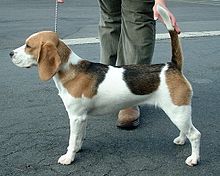 The Beagle is a small to medium-sized hound. It is similar in appearance to the Foxhound, but smaller, with shorter legs and longer, softer ears. Beagles are scent hounds, developed primarily for use on foot, tracking hare, rabbit, and other game. They have a great sense of smell and tracking instinct that sees them employed as detection dogs for prohibited agricultural imports and foodstuffs in quarantine around the world. Beagles are intelligent, and are popular as pets because of their size, even temper, happy to live in groups, and lack of inherited health problems. However these endearing characteristics also make them the dog of choice for animal testing.
The Beagle is a small to medium-sized hound. It is similar in appearance to the Foxhound, but smaller, with shorter legs and longer, softer ears. Beagles are scent hounds, developed primarily for use on foot, tracking hare, rabbit, and other game. They have a great sense of smell and tracking instinct that sees them employed as detection dogs for prohibited agricultural imports and foodstuffs in quarantine around the world. Beagles are intelligent, and are popular as pets because of their size, even temper, happy to live in groups, and lack of inherited health problems. However these endearing characteristics also make them the dog of choice for animal testing.
Beagles may exhibit a behaviour known as reverse sneezing, in which they sound as if they are choking or gasping for breath, but are actually drawing air in through the mouth and nose. The exact cause of this behaviour is not known, but it is not harmful to the dog.
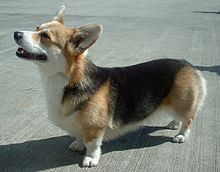 It must be said that life is never dull with a corgi, they are bold, spirited and energetic dogs, and are loyal companions, but do have a tendency to take over the home if you let them. The Pembroke Welsh Corgi is a herding dog breed, which originated in Pembrokeshire, Wales. It is one of two breeds known as Welsh Corgi: the other is the Cardigan Welsh Corgi. The most obvious difference between the Pembroke and the Cardigan is that the Pembroke lacks a tail while the Cardigan has a long tail. The Pembroke usually has straighter legs as it is not quite as long- bodied as a Cardigan; the Pembroke’s head is generally more wedge-shaped; the ears are smaller and closer together than the Cardigans; also the Pembroke tends to be lighter.
It must be said that life is never dull with a corgi, they are bold, spirited and energetic dogs, and are loyal companions, but do have a tendency to take over the home if you let them. The Pembroke Welsh Corgi is a herding dog breed, which originated in Pembrokeshire, Wales. It is one of two breeds known as Welsh Corgi: the other is the Cardigan Welsh Corgi. The most obvious difference between the Pembroke and the Cardigan is that the Pembroke lacks a tail while the Cardigan has a long tail. The Pembroke usually has straighter legs as it is not quite as long- bodied as a Cardigan; the Pembroke’s head is generally more wedge-shaped; the ears are smaller and closer together than the Cardigans; also the Pembroke tends to be lighter.
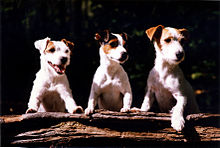 The Jack Russell terrier is a small terrier that has its origins in fox hunting. It’s usually a white-bodied dog and can have a variety of coat types, smooth, rough or broken-coated. Often any small white terrier is identified as a Jack Russell.
The Jack Russell terrier is a small terrier that has its origins in fox hunting. It’s usually a white-bodied dog and can have a variety of coat types, smooth, rough or broken-coated. Often any small white terrier is identified as a Jack Russell.
The Jack Russell is an energetic breed which relies on a high level of exercise and stimulation, and is relatively free from serious health complaints. It has gone through several changes over the years, through different use and breed standards set by kennel clubs. Recognition for the breed by kennel clubs has been opposed by the breed’s parent societies – which resulted in the breeding and recognition of the Parson Russell terrier.
Raw Feeding
Raw feeding is the practice of feeding domestic dogs, cats and other animals a diet primarily of uncooked meat, edible bones, and organs. There have been many claims about the advantages of the diet over commercial processed food and this article hopes to bring you some of the arguments for and against this way of feeding your pet to help you make up your own mind. I’ve tried to avoid bias, and present a balanced view.
Those in favour of the diet cite many health benefits to their animals but there have been few scientific studies carried out to prove or disprove these claims.
Proposed benefits for a BARF diet include:
Reduced doggy odour and ‘dog breath’.
Naturally cleans teeth – no need for toothbrushes, de-scaling, helps prevent gum disease leading to improved general health.
Chewing raw meaty bones cleans teeth and supplies minerals, but, very importantly, dogs love it!
The time it takes for a dog to chew raw meaty bones gives their stomach time to get the acids moving.
Produces firmer, more ‘pick-upable’, smaller stools.
Can reduce vet bills (healthier dogs)
Economical to feed in comparison to quality commercial dog foods.
Puppies develop at a more appropriate rate. Quick growth spurts are avoided.
Better weight control which helps to reduce the symptoms of arthritis and obesity.
Some long standing bowel problems (e.g. constant or recurrent diarrhoea) and skin problems (chewing feet, recurrent ear infections or constant scratching) can be cured with raw food and careful selection of ingredients.
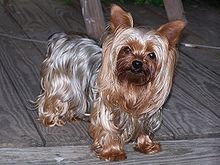 The Yorkshire Terrier is a small terrier type dog developed in the 19th century in the county of Yorkshire, England to catch rats in clothing mills. The defining features of the breed are its size, 3 pounds (1.4 kg) to 7 pounds (3.2 kg), and its silky blue and tan coat. The breed is nicknamed Yorkie and is placed in the Toy section by the kennel clubs, although all agree that the breed is a terrier. A popular companion dog, the Yorkshire Terrier has also been part of the development of other breeds, such as the Australian Silky Terrier.
The Yorkshire Terrier is a small terrier type dog developed in the 19th century in the county of Yorkshire, England to catch rats in clothing mills. The defining features of the breed are its size, 3 pounds (1.4 kg) to 7 pounds (3.2 kg), and its silky blue and tan coat. The breed is nicknamed Yorkie and is placed in the Toy section by the kennel clubs, although all agree that the breed is a terrier. A popular companion dog, the Yorkshire Terrier has also been part of the development of other breeds, such as the Australian Silky Terrier.
Yorkies seem oblivious of their small size. They are very eager for adventure. They are highly energetic, brave, loyal and clever. With owners who take the time to understand how to treat a small dog, the Yorkie is a wonderful companion! Affectionate with their master, but if humans are not this dog’s pack leader, they can become suspicious and aggressive to strangers both animal and human. They can also become yappy, as the dog does their best to tell you what THEY want YOU to do. They have a true terrier heritage and need someone who understands how to be their leader, otherise thet can develop Small Dog Syndrome. Yorkies who become demanding and dependant appearing to need a lot of human attention and/or developing jealous behaviours, snapping if surprised, frightened or over-teased or eve ndon’t get heir own way over food or sleeping places. Owners who do not instinctually meet the dogs needs can also find them to become over-protective, and even neurotic. The basic message is to remember that although small, a Yorkie is a dog, not a toy and needs the discipline that all dogs do in order to be a happy and contented member of your household.
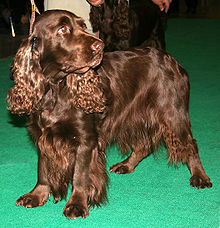 One of the handsomest and possibly most noble looking of all the Spaniel varieties, the Field Spaniel has had a chequered career since the breed evolved some 150 years ago. Their fur is lighter than other spaniels and have no undercoat. Their coats come mostly in solid colours with some occasional markings on the chest. They can make good family dogs and are patient with children, but can require some sort of purpose, be it hunting or agility work in order to prevent them from becoming bored and destructive.
One of the handsomest and possibly most noble looking of all the Spaniel varieties, the Field Spaniel has had a chequered career since the breed evolved some 150 years ago. Their fur is lighter than other spaniels and have no undercoat. Their coats come mostly in solid colours with some occasional markings on the chest. They can make good family dogs and are patient with children, but can require some sort of purpose, be it hunting or agility work in order to prevent them from becoming bored and destructive.
They are considered to be a rare breed, and are registered as a Vulnerable Native Breed by The Kennel Club, with only 55 puppies registered in 2011 and 51 in 2009, it has been in steady decline since 2000. Out of all the Spaniel breeds registered with The Kennel Club, the Field Spaniel has the lowest numbered registered year on year, with only the Sussex Spaniel coming a close second with 60 registrations in 2009. This is compared to the English Springer Spaniel with 12,700 and the English Cocker Spaniel with 22,211 registrations in 2009 alone.
 The Curly-Coated Retriever is a large dog, the most distinctive feature being his coat. The water-resistant coat is very distinct coat with small, tight, curls that cover every part of the body accept for the forehead, face, front of forelegs, and feet. The coat protects the dog from brambles and icy waters. The Curly-Coated Retriever is a high-energy, but also very intelligent dog that needs a lot of exercise, both mental and physical. Preferably involving swimming and retrieving, which they love.
The Curly-Coated Retriever is a large dog, the most distinctive feature being his coat. The water-resistant coat is very distinct coat with small, tight, curls that cover every part of the body accept for the forehead, face, front of forelegs, and feet. The coat protects the dog from brambles and icy waters. The Curly-Coated Retriever is a high-energy, but also very intelligent dog that needs a lot of exercise, both mental and physical. Preferably involving swimming and retrieving, which they love.
easy to get along with, this breed is loyal and eager to please. Proud and confident, very intelligent and trainable, which means it needs quite a lot of stimulation to remain contented. They have been used in competitive obedience and agility, but are not as predictable as some other breeds, as they can get bored with a the same actions over and over again. Curlies do not fully mature until they are about three years old and can be willful with meek owners. Make sure you are the dogs firm, but confident, consistent pack leader to bring out the best in their temperament. The Curly-Coated Retriever is affectionate, loving, and excellent with children. The more mental and physical exercise you give them the calmer they will be. Socialize them well with people and other pets at an early age. Without proper balance in their life they can be reserved or timid with strangers.
Dog intelligence is the ability of a dog to learn, think, and solve problems. Dog trainers, owners, and researchers have as much difficulty agreeing on a method for testing canine intelligence as they do for human intelligence. One specific difficulty is confusing a breed’s genetic characteristics and a dog’s obedience training with intelligence.
Stanley Coren, a psychologist defined three aspects of dog intelligence.
Instinctive intelligence refers to a dog’s ability to perform the tasks it was bred for, such as herding, pointing, fetching, guarding, or supplying companionship.
Adaptive intelligence refers to a dog’s ability to solve problems on its own.
Working and obedience intelligencerefers to a dog’s ability to learn from human.
He ranked many breeds registered by the American and Canadian kennel clubs based on Working and obedience intelligence, and other studies have generally agreed with his findings.
However like with people there are bright and not so bright dogs within a breed and many dogs don’t fit into a specific breed group anyway. But consider that although there might be some kudos in owning a very intelligent dog, if your dog is very bright it’ll need a lot of mental stimulation to remain content. On the other hand if your ever loving doggy companion is in the ‘fair’ category or ‘lower’ (politically correct to the last!) you might want consider him/her ‘stubborn’ or having ‘ a will of his/her own’ rather than a bit ‘ Tim Nice But Dim’.